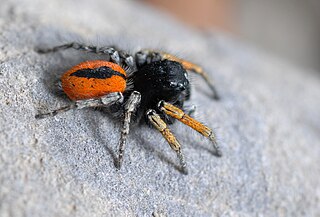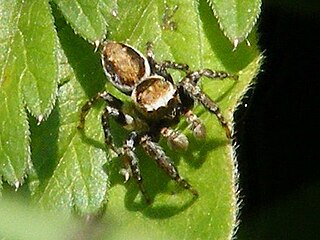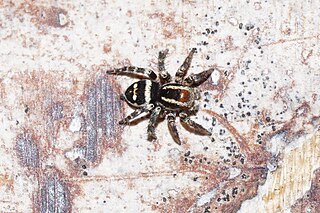
Philaeus chrysops is a species of jumping spider (Salticidae).

Carrhotus xanthogramma is a species of jumping spider belonging to the family Salticidae.

Pseudomogrus mirandus is a species of jumping spider in the genus Pseudomogrus. It has been found in Turkmenistan on the steppe, although it may also live in Afghanistan and Iran. The species was first defined by Wanda Wesołowska in 1991, one of over 500 described by the arachnologist. She originally placed it in the genus Yllenus, but was moved to the new genus Logunyllus in 2016, and then to its present designation in 2019. The spider is small, with a carapace measuring between 1.6 and 1.78 mm long and an abdomen between 1.4 and 2.3 mm long. The male has a red-brown or dark brown carapace and dark grey abdomen, the female a brown carapace and greyish-brown abdomen. All have a covering of small white scales. The spider has yellow legs. The copulatory organs are distinctive and enable the spider to be distinguished from others in the genus. The female epigyne has a half-moon-shaped pocket and simple insemination ducts that lead to spherical spermathecae. The male lacks the ventral tibial apophysis common in other species and has a compound terminal apophysis that is of a similar length to its thin embolus.

Menemerus zimbabwensis is a species of jumping spider in the genus Menemerus that lives in South Africa and Zimbabwe. The Polish arachnologist Wanda Wesołowska first described the female in 1999 and the male in 2007. The spider is large, with a cephalothorax that is between 1.9 and 3.2 millimetres long and an abdomen that is between 2.1 and 4.6 millimetres in length. The female is larger than the male. It also lacks the light stripe down the centre of its dark brown carapace and has a less distinct pattern on its abdomen. Its legs and pedipalps are yellow, while on the male they are brown. The male can be distinguished from the similar Menemerus nigli by the wide stripe on its abdomen. The female is harder to identify without looking at its copulatory organs. These are distinctive. It has characteristic large entrance bowls on its epigyne, which are larger than the insemination ducts and spermathecae combined. Its internal organs are very sclerotized.
Nigorella aethiopica is the type species of the genus Nigorella. A jumping spider that lives in Ethiopia and named in honour of the country in which it is found, it was first described in 2008 by Wanda Wesołowska and Beata Tomasiewicz. The spider is larger than others in the species with a cephalothorax that is between 4.1 and 4.8 mm long and an abdomen that is between 4.3 and 5.6 mm long. The carapace is generally brown and hairy, although the male is darker. While the male abdomen is marked by a light stripe on the topside and dots underneath, the female abdomen has a pattern of a light stripe and patches on the top and dark stripes on the bottom. As well as the larger size, there is a split at the end of the appendage on the pedipalp tibia that marks out the male, and the female has longer seminal ducts and thinner spermathecae than others in the genus.

Evarcha flagellaris is a species of jumping spider in the genus Evarcha that lives in Kenya and South Africa. The species was first described in 2011 by Charles Haddad and Wanda Wesołowska. The spider is small, with a carapace measuring between 2.0 and 2.4 mm long and an abdomen between 1.9 and 3.6 mm long. The female is larger than the male, particularly in the size of its abdomen. Both have stripes on the abdomen, the male being more distinct with four brown stripes contrasting with a yellow background. This is similar to the related Evarcha striolata, from which it can be distinguished by the presence of an orange scutum. It can also be identified by its copulatory organs. The female has very wide looping insemination ducts that lead to heavily sclerotized multi-chambered spermathecae. The male has a long straight projection from its tibia or tibial apophysis and a whip-like embolus. It is after the latter feature that it is named.

Evarcha aposto is a species of jumping spider in the genus Evarcha that lives in Ethiopia and Nigeria. The species was first described in 2008 by Wanda Wesołowska and Beata Tomasiewicz. It is named for the place in Ethiopia where is was first found. The spider is small, with a cephalothorax measuring between 1.9 and 2.2 mm long and an abdomen between 1.8 and 1.9 mm long. The carapace is generally light, yellow or fawn, with a dark stripe down the middle and occasionally a thin stripe to the rear. The abdomen is yellow with a pattern of darker patches. It has a black eye field. The front legs are darker, brown in the case of those found in Nigeria and black for the Ethiopian examples. The remaining legs have a distinctive top half that is black or brown, the remainder being yellow. Its copulatory organs are distinctive, particularly the male's very short embolus, which is accompanied by a spoon-like appendage. The female has not been described.

Evarcha awashi is a species of jumping spider in the genus Evarcha that lives in Ethiopia. The species was first described in 2008 by Wanda Wesołowska and Beata Tomasiewicz. The spider is small, with a cephalothorax measuring between 2.0 and 2.3 mm long and an abdomen between 1.9 and 2.4 mm long. The male and female are similar in size but differ slightly externally. The male carapace is orange while the female is brown, both with a darker eye field. The pattern on the abdomen is generally similar, a combination of light background and dark patches, but the female has less contrast between the two. The legs are mainly brown with yellowish tarsi. Its copulatory organs are distinctive. The male has a short embolus that follows the palpal bulb and a sharp tooth on its short wide and blunt protrusion on its palpal tibia, or tibial apophysis. The female has insemination ducts that narrow into multi-chambered spermathecae.

Pseudomogrus logunovi is a species of jumping spider in the genus Pseudomogrus that lives in United Arab Emirates. The species was first defined by Wanda Wesołowska and Antonius van Harten in 2010. They originally placed it in the genus Yllenus, but it was moved to the new genus Logunyllus in 2016, and then to its present designation in 2019. The spider is small, with a cephalothorax that is between 1.5 and 2.0 mm long and an abdomen between 1.6 and 2.2 mm long. The female is larger than the male. The female has a plain brown carapace while the male has two white stripes on its darker surface. Both have brown patches on their yellow legs. The spider can be identified by its copulatory organs. The male has a straight spike on the tibia of its pedipalps, or tibial apophysis, a long embolus with a narrow accompanying terminal apophysis and a small tegulum. The female has shorter insemination ducts than species like Pseudomogrus salsicola.

Aelurillus galinae is a species of jumping spider in the genus Aelurillus that is endemic to the United Arab Emirates. It was first described in 2010 by Wanda Wesołowska and Antonius van Harten. The species is small with a cephalothorax that is between 1.5 and 1.8 mm long and an abdomen that is between 1.4 and 2.2 mm long. The female is larger than the male. The female has a spherical abdomen that has a grey and fawn pattern. The male abdomen has a wide brown stripe across the middle and is otherwise yellow. The carapace of both similar. The species is distinguished by the way that the front set of eyes extend beyond the front of the carapace and the way that the appendages on the male palpal bulb have blended.
Ragatinus maddisoni is the type species for the genus Ragatinus. It is a species of jumping spider that is endemic in Kenya, living in forested afromontane regions. First described in 2016 by Angelika Dawidowicz and Wanda Wesołowska, it is named after the arachnologist Wayne Maddison. The spider is medium-sized and generally light brown, with a cephalothorax that is between 2.0 and 3.0 mm long and an abdomen between 2.2 and 4.0 mm long. It has light brown legs, the foremost ones being longer and darker. The species is most easily distinguished from other spiders by its copulatory organs. The female has a triangular depression in the middle of its epigyne and the male has a protuberance with teeth attached to the base of its curved embolus.

Phintella parva is a species of jumping spider in the genus Phintella that lives in China, Japan, Korea and Russia. The species was first described by Wanda Wesołowska in 1981 based on a holotype from North Korea. However, retrospectively; it was recognised that other examples of the spider had been previously collected and, at one time, a description published without a species name. The spider is small, between 3.5 and 4 mm long, and yellow. The female is slightly larger than the male. The abdomen has a striped pattern and the carapace has circular markings, but the most distinguishing difference between this species and other members of the genus are its copulatory organs, particularly the short curved embolus on the male and long straight insemination ducts in the female.

Plexippoides regius is a species of jumping spider in the genus Plexippoides. The species was first described by Wanda Wesołowska in 1981 based on specimens from North Korea but its distribution has been extended to include China, Russia and South Korea, with examples found as far as Sichuan. The spider is small, with a body length between 6.9 and 8.65 mm, the female being generally larger than the male. It is distinguished by the two brown lines that stretch across the back of its carapace and abdomen that is recalled in its Korean name. Otherwise, the spider varies in coloration, with some examples having an orange or yellow-brown carapace and others dark brown. The male has a long embolus that encircles the palpal bulb. The female has complex seminal ducts that lead to heavily sclerotised and many-chambered spermathecae.

Stenaelurillus hirsutus is a species of jumping spider in the genus Stenaelurillus that lives in Central Africa, Congo, Ghana, Kenya, Senegal, Tanzania, and Uganda. It was first described in 1927 by Robert de Lessert. The spider is small, with a cephalothorax that ranges in length between 2.3 and 2.7 mm in length and an abdomen between 2.4 to 2.5 millimetres long. The male is distinguished by its black and white striped pattern on the anterior of the carapace and a mane of light-coloured hairs around the eye field that are reminiscent of a Mohawk hairstyle. The female's epigyne has a deep narrow pocket and bean-shaped copulatory openings. The clypeus has a distinctive pattern of three vertical white stripes on its otherwise black exterior.

Stenaelurillus zambiensis is a species of jumping spider in the genus Stenaelurillus that lives in Malawi, Zambia and Zimbabwe. It was first described in 2014 by Wanda Wesołowska. The spider is small, the male being smaller than the female, with a brown carapace between 2.6 and 3.2 mm in length and black-brown abdomen between 2.6 and 3.0 mm in length. The male has a distinctive metallic sheen on its abdomen and eye field. The male carapace is marked with two white streaks while the female has white stripes. It is distinguished from other members of the genus by the male's hook-shaped end to the embolus and the two depressions in the female epigyne.

Stenaelurillus iubatus is a species of jumping spider in the genus Stenaelurillus that in endemic to Nigeria. It was first described in 2011 by Wanda Wesołowska and Anthony Russell-Smith. The spider is medium-sized, with a brown carapace between 2.7 and 2.95 mm in length and abdomen between 2.3 and 3.25 mm in length. The male has two stripes of white scales on the carapace and the female has a heart-shaped white spot on the abdomen. The spider has a distinctive mane-like long hairs on its black eye field, which is recalled in the species name that is derived from the Latin for mane. It can be distinguished from other species in the genus by the ribbon-shaped embolus on the male and highly sclerotized epigyne with its narrow pocket and widely separated copulatory openings on the female.

Stenaelurillus albus is a species of jumping spider in the genus Stenaelurillus that lives in India. It was first described in 2015 by Pothalil A. Sebastian, Pradeep M. Sankaran, Jobi J. Malamel and Mathew M. Joseph. The spider was first found in Kerala but has also been observed in Karnataka, including the Mookambika Wildlife Sanctuary and Parambikulam Tiger Reserve. It prefers to live in the leaf litter found in deciduous forests. It is medium-sized, with a body length that ranges from 4.61 to 6.82 mm. The female is larger than the male. The female has a black oval cephalothorax which has a pattern of yellow bands and an oval abdomen that has yellow patches, the most pronounced three of which make a triangle shape, on a black background. The male differs in having a shiny black abdomen which has no patterns and a cephalothorax that is black with thick white stripes that mark the spider from front to back. This pattern distinguishes the species from others in the genus, including Stenaelurillus belihuloya. The sexual organs are also distinctive. The male has a brown palpal bulb that has two creamy-white markings on the rear and has a short, blunt embolus. These areas give the spider its name, from the Latin for white. The female has wide copulatory openings and small C-shaped spermathecae, and it is the latter that enables it to be distinguished from Stenaelurillus abramovi.

Stenaelurillus albopunctatus is a species of jumping spider in the genus Stenaelurillus that lives in Kenya. It was first described in 1949 by Ludovico di Caporiacco. The spider is medium-sized, with a cephalothorax between 2.24 and 23.55 mm long and abdomen between 2.38 and 3.92 mm long. It has two white stripes on its carapace and white speckles or spots on its abdomen. The female is generally lighter than the male. For example, the female has a brown and yellow carapace, which in the male is brown or black. The female clypeus and legs are yellow, while on the male they are brown. Otherwise, the colouration is similar to many other species in the genus. It is this similarity that led to the species Stenaelurillus guttiger being recognised as a member of the genus. The male has a spatula-like appendage at the front of its yellow pedipalps and a short thick embolus. The female has copulatory openings positioned very closely together and short insemination ducts.

Stenaelurillus nigricaudus, synonyms Aelurillus sahariensis and Stenaelurillus nigritarsis, is the type species of the genus Stenaelurillus. It is a jumping spider that lives in Algeria, Burkina Faso, Gambia, Mali, Niger and Senegal. The male was first described by Eugène Simon in 1886 and the female initially in 1936 by Ludovico di Caporiacco and more thoroughly by Nikolaj Scharff and Tamás Szűts in 2005. It is a medium-sized spider with a cephalothorax between 2.4 and 2.7 mm and an abdomen that is between 2 and 3.7 in long. The carapace is reddish-brown and has two white or yellow stripes. The female abdomen has a pattern of stripes and spots, with some examples having brown spots inside yellow spots. The male abdomen has either a single dark stripe or two white and one brown stripes. While the female pedipalps are yellow, the male has either dark or brown pedipalps. The female has distinctive flanges at its copulatory openings. The male is distinguished by the shape of its palpal bulb and, particularly, of its hook-shaped embolus.

Pseudicius africanus is a species of jumping spider in the genus Pseudicius that lives in Lesotho and South Africa. The spider was first defined in 1903 by George and Elizabeth Peckham. It is small, with an oval cephalothorax measuring between 2 and 2.5 mm in length and an ovoid abdomen that is between 2.2 and 2.5 mm in length. The female is smaller than the male. Otherwise, they are similar, generally dark brown but with white stripes, made of hairs, down the middle and the along the sides of the top of both the carapace and abdomen. The underside of the abdomen differs in being grey and marked by two lighter lines. The female's legs are also lighter, and the front legs on the male are stouter than all the others. The pattern on the abdomen helps distinguish the spider from the related Pseudicius maculatus. It also has distinctive copulatory organs. The male has a shorter curved embolus and a characteristic tooth near the base of the tibial apophysis, or spike on the palpal tibia. The female has copulatory openings are on the edges of its epigyne.






















